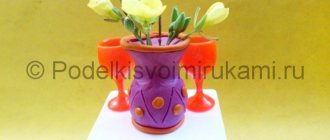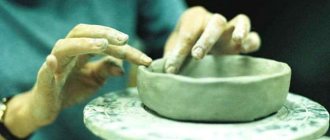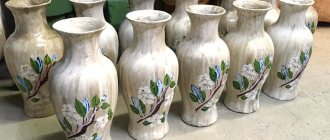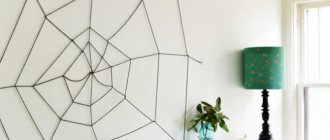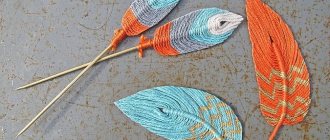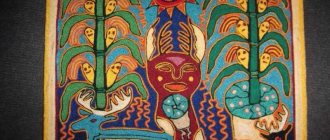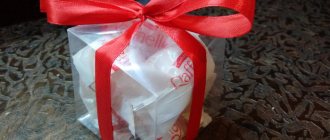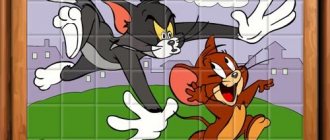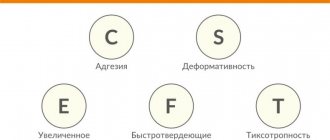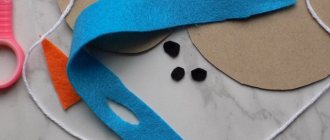The apartment will look much more comfortable if you add a few homemade decorations to the interior.
Things made with your own hands accumulate the energy of the person who made them, and look much more attractive than items produced in millions of copies. Making does not take much time, but the result is worth it. This product will fit perfectly into the interior and will arouse the interest of guests.
We suggest making your own vase from yarn and PVA glue.
How to make a vase from threads with your own hands
A do-it-yourself vase made from thread is an easy-to-make and elegant souvenir. It can be made in two ways - on a balloon or using a solid frame. Even a child can master the creative process. The principle is based on the fact that the threads are wetted with glue, which then hardens. The structure hardens into the shape you gave it.
In the shape of a heart
Let's consider another candy bowl, which will be an excellent gift for your significant other, especially those who love sweets. This product will also delight children who adore unusual things. It is noteworthy for its heart shape, which can show your feelings both for the person and for the candies themselves. To create such a candy bowl you will need not only threads, but also toothpicks. Let's take a closer look at the required materials:
Thick cardboard It will serve as the bottom for the future product, so you should pay attention to its thickness. The cardboard should easily withstand the candies placed on it; Glue “Moment” Instead, you can use any other glue that will also firmly connect the bottom to the toothpicks; Directly toothpicks, which will become the basis for the walls of the future candy bowl; Multi-colored threads
Popular articles DIY Christmas nativity scene - interesting master classes and beautiful photo ideas
Don’t be afraid to experiment with the number of colors - their variety will only make the craft more beautiful, you just have to think about color combinations and do not forget that it is important not to overload the overall picture; Various beads and rhinestones are perfect for decorating a candy bowl. They will give the craft a finished look.
Prepare the bottom: cut out a heart of the desired size from cardboard. Be careful and try not to touch the inside of it. To make the task easier, you can use a ready-made template and cut according to it.
After this, trim off all the sharp ends of the toothpicks. Try to make them straight and without jagged edges, as they can damage the bottom of the future product.
Glue toothpicks vertically onto the cut out heart. It is worth stepping back a centimeter from the edge, this will give the candy bowl stability.
The next stage is the most labor-intensive - you need to braid the resulting base for the wall from skewers and toothpicks. Do this in zigzags and weave in beads as you go for added beauty.
Finally, decorate the candy dish by gluing sparkles and rhinestones onto it. It all depends on your imagination. In any case, a handmade craft will certainly delight your family, loved ones and loved ones.
What you will need
To make the product you will need:
- Threads - knitting, floss, twine or even sewing. The thinner they are, the longer it will take to wrap the structure.
- Balloon. It’s better to have several at once, in case something goes wrong.
- A plastic or glass container (if you are using a solid frame) onto which the thread will be glued. The base needs to be wrapped with cling film.
- Stationery glue or potato starch paste. For strength, you can add a little PVA to it.
- Decor that depends only on your creative imagination. The lace trim, bows, and flowers look cute and touching.
To attach decorative elements, it is convenient to use a glue gun with silicone.
Candlestick "lotus"
It's not even a craft.
A real stylish decor item! Despite the fact that the candlestick is made from scrap materials, it looks amazing. The base is a short, pot-bellied glass made of transparent glass.
Take about a couple of dozen spoons, break off the handle, leaving only the oval part.
Using a glue gun, starting from the top, glue the spoons in a circle onto the walls of the glass, so that the lower part of the spoon is hidden under the upper part of the spoon going below.
To make the bottom of the candlestick look neat, you can wrap it around the very edge with twine or white satin ribbon. Place the candlestick on a ceramic saucer. Several glasses decorated in this way will create a beautiful floral arrangement with Japanese notes.
Step-by-step instruction
The process of creating a vase is as follows:
- The first step is to inflate the balloons. You can create vases that are quite large in size - the glued thread will hold its shape well. Naturally, the more the product is needed, the more the balloon is inflated.
- From a tube of glue you need to build a structure through which the thread will pass, wetted with the composition. It will be convenient for someone to soak the entire skein in the mixture or come up with another way. It is important that the threads are attached to the ball and that their entire mass is well saturated with glue.
- After careful wrapping, the structure is sent to dry. It is better to do this in the sun, but you can do it near a radiator or with a hairdryer.
- After all the threads have dried and the workpiece has hardened, you can remove the ball. First the tail is cut off. Then the ball is pierced with a needle. You will hear it hissing and crackling, gradually deflating and separating from the walls of the thread frame.
- You can remove the ball after the hole is cut. The frame cuts very well. You can give the vase any look - a shallow bowl, a spherical vase, a basket, a house with a window. From one oval blank you get two products if you cut the frame in half.
- After the hole is made and the ball is removed, it is time to decorate. You can decorate the surface of the vase with flowers, lace, and attach butterflies or ladybugs to it.
If the vase is made on a solid frame, then threads moistened with glue are laid out on the outside of the container. Then everything is exactly the same as in the first method - drying, removing from the base, decorating.
Simple option
This technique does not have a specific name, but in its execution it is quite simple. You just need to be patient and prepare the following materials:
- Two inflatable balls (one of them is a spare);
- Threads. You can experiment with their thickness and color. See what result a thick thread will give and what will happen with a thinner one (you shouldn’t take too thin ones, they may not withstand the weight and will fall apart). An excellent solution for design would be threads in two colors. This way it will be nice not only to take cookies and sweets from the vase, but also just to look at it;
- PVA glue.
Decide on the size of the future candy bowl; its capacity and the amount of thread spent on it will depend on this.
After that, take a balloon and inflate it according to the selected size. Don't forget to tie its tail with a thread so that it doesn't fall down. If the balloon bursts during the process, don’t worry - that’s why we took a spare one.
Prepare the glue: pour a small amount of water into a deep bowl, add PVA to it and mix the resulting mixture well.
Unwind the thread and dip it into the glue solution. After this, it will easily stick together and, once hardened, will create a reliable base for the candy dish.
Next, wrap the prepared thread around the balloon. You can do this in any way - straight lines, all kinds of bends or loops, everything will depend on your imagination. To make the candy bowl stronger, layer the threads on top of each other in two, three or four layers, depending on their thickness.
The next thing to do is to let the threads dry. To do this, hang the ball by the tail and leave it in this position for a day.
It is important to ensure that the threads do not touch anything, because they are still adhesive, and there is a risk of damaging the future candy dish when peeling off from an accidentally touched object. Also, if you want the product to dry faster, take care of the high temperature, but remember that the ball may burst from the heat, and this is highly undesirable until the glue has completely dried
After a day has passed and the thread has had time to dry, it needs to be separated from the ball. To do this, you can either simply burst it with a needle, or cut it with scissors near the tail. This process is extremely unpleasant, but it is necessary in order to be able to use the candy dish.
So, the threads have separated from the ball, the original decoration of your kitchen is ready. It will add coziness to the room and dilute the everyday life of the sweet tooth with its unusual look, which you created with such a reserve of patience. If desired, you can strengthen the strength of the product by covering it with another layer of glue so that it does not sag under the weight of the candies.
DIY vase made of thread and glue
The apartment will look much more comfortable if you add a few homemade decorations to the interior.
Things made with your own hands accumulate the energy of the person who made them, and look much more attractive than items produced in millions of copies. Making does not take much time, but the result is worth it. This product will fit perfectly into the interior and will arouse the interest of guests.
We suggest making your own vase from yarn and PVA glue.
Jute filigree
Jute filigree is a technique that requires perseverance and patience. It is used to make various patterned crafts.
Before you start doing anything, prepare the following additional materials:
- tweezers;
- thin knitting needle;
- Titan glue or regular PVA;
- awl;
- scissors;
- jute thread.
If you are a beginner and have not encountered this technique before, then you will need a stencil. You can buy it at any art store or draw it yourself. In the photo below you can see an example of a diagram for beginners.
Don't start with complex products - practice and make a simple napkin first. It will be useful in the kitchen or can act as decoration for a vase.
- Before you start working, cover your stencil or design with film.
- Apply glue along the contour of the design and attach jute twine.
- Help with the knitting needle so that the thread is light and matches the pattern.
- Complete the product with decorative elements. Beads or rhinestones are ideal and will make your product more beautiful and original.
- After finishing work, let the napkin dry - this will take at least 6 hours.
- Once everything has hardened, use a knife to carefully peel the napkin from the base. You can coat it with varnish - this will give the product an attractive shine.
Some works may consist of 2 or more parts that are connected together.
Pay attention to the step-by-step instructions on how to make a jute napkin holder with your own hands. It consists of several parts that are connected after the first drying and dried for another 6 hours
Thanks to this technique you can make and decorate a lot of things. If you are interested in jute filigree, we suggest you familiarize yourself with some interesting and unusual ideas in the photo. Get inspired and create!
Such cute toys will not only decorate your home, but are also suitable as a gift.
Jute products can be spray painted or decorated with other additional materials.
Stones, beads and rhinestones - all this can be used in your crafts.
You may be interested in: DIY photo frames
Paintings made using this ancient technique look very original and elegant.
Jute twine is an ideal raw material for handicrafts. It has a natural color and excellent decorative qualities. Thanks to this, all products look very interesting and beautiful in any interior. All crafts made from jute twine are easy and simple to make with your own hands; you just need patience and very little time. As a result, you will get unique works.
Vase made of threads and glue in the interior. Interesting models
We also offer a master class on an original heart-shaped vase. It is especially relevant on the eve of Valentine's Day. In such a vase you can store sweets, tea bags, and cute trinkets. Children will also be delighted with the vase. This craft will help you express your feelings for your loved one.
List of required materials :
- First you need to make the bottom. To do this, you need to cut out a piece of cardboard in the shape of a heart. You can print the finished template if you doubt that you can draw an even heart.
- We cut each toothpick on both sides so that there are no sharp ends on them.
- Toothpicks are glued along the edge of the heart. In order for the vase to stand, it is necessary to retreat 1 cm from the edge.
- We braid toothpicks with threads. You can use beads and sew-on rhinestones as decoration, weaving them into your work.
- We decorate the vase with rhinestones, ribbons, and beads. Feel free to use your imagination and then you will definitely end up with a beautiful vase. This interior decoration will delight your family and friends.
- You can put an embroidered napkin or just a beautiful piece of fabric in the middle of the vase. You can also make a lid for the vase, and then you will get a box for jewelry and various small items.
Simple crafts with jute patterns for beginners: photo frame with filigree pattern
The first work in the jute filigree technique is the design of a photo frame.
In order to make this jute product with your own hands, you will need:
- a small piece of stiff cardboard (you can use cardboard from a shoe box);
- a piece of paper of any dark color;
- wooden skewers;
- a small piece of wire, suitable in cross-section to the thickness of the skewer;
- jute twine;
- any beads for decoration;
- glue;
- tweezers;
- scissors, stationery knife.
A photo frame with an openwork filigree pattern will have a rectangular shape, rounded like an arch at the top. The external dimensions of the frame are height 13 cm, width 11 cm. The internal window for the photo is 7 cm wide and 9 cm high. The height of the upper part of the frame is 6 cm. We draw a drawing of the frame on cardboard and cut out the blank. This will be the basis for the openwork pattern. You can cover the blank with any colored paper. It must be kept in mind that an openwork pattern looks better on a dark background.
The width of the side openwork jute filigree pattern is 1.5 cm. We mark the scan and make a pattern. Place the drawing in a file folder.
When making this jute craft, you first need to work with the cardboard base.
We will decorate a cardboard frame covered with colored paper along the outer edge and inside the photo window with borders.
To do this, we wrap skewers coated with glue with jute twine. We do the same with a piece of wire. We cover the upper rounded edge of the frame with this flexible border.
Cutting the resulting borders to the required length, glue them directly to the ends of the frame. To cover the gluing area between the border and the cardboard frame, glue a piece of jute between them along the entire length, both on the front and back sides of the frame.
Popular articles Clawed monster
Using the jute filigree technique, we will make a pocket for a photo on the reverse side of this product. Glue the skewers, stepping back from the window 5-7 mm from the bottom and sides. We glue a piece of cardboard on top that is suitable in size so that the photo does not fall out of the pocket.
Let's move on to more interesting work - a set of openwork patterns made of jute. We remember that you need to cut the cord at an angle so that the cut ends of the elements do not puff up and stick together more tightly.
Let's start from the bottom of the frame and then move to the sides. First we make the large elements of the drawing. After they are glued, we will move on to a set of smaller elements.
Using a toothpick or the thin end of a skewer, spread the glue along the pattern line for the jute product.
Glue the curls to this place. We supplement large curls with loops and smaller curls according to the pattern. We make all the elements from separate pieces of jute, firmly glue them to each other, and press the gluing points with tweezers or a finger. If you have squeezed out a lot of glue, you can spread it over the surface of the design or remove it and spread it on jute twine to make it less shaggy. If the excess is not removed, the elements may creep and begin to bulge.
After a set of sides, we proceed to the jute pattern above the top. We start with the central small curls. Then we glue the arched crossbar between the curls.
While this part of the drawing for a DIY jute craft is drying, we begin to make large petals.
It's better to start from the center. We form each petal from two pieces of cord.
In the upper, pointed part of the element, use tweezers to press the ends of the rope against each other so that they stick together tightly and do not move apart.
While we were making the contours of the petals, the central part dried out, and its contours did not spread to the sides. We fill it according to the drawing with small elements in the form of loops.
Next we will continue working with large petals. We do the internal filling according to the drawing. Smaller petals are placed between the large petals.
When the set of designs for crafts made from jute twine is ready, we place it under the press so that later the design remains even and the elements are on the same level. Let it dry for three to four hours.
Then we remove the work from the film. All visible glue drips along the edges and between the elements are cut off with a stationery knife from the wrong side.
This is a painstaking but very important stage. Excess glue must be carefully removed so that the work looks neat and beautiful. We carefully inspect the cleaned work.
We apply it to the cardboard blank.
The openwork pattern does not fit closely to the cardboard, but is located slightly above the colored background of the frame. It sticks to the curbs. And this creates an even larger volume of openwork pattern.
And now you can decorate the openwork pattern with beads to your taste, as your imagination dictates.
Master class: vase made of threads - fast, easy, beautiful!
Hello, dear readers! In today's master class, I want to tell you how to make a vase from threads. The process of making a vase will not take much time and effort, and the result will definitely please you. Such a vase made of threads will definitely fit perfectly into any interior and will arouse the interest of your guests... Well, let's get started!
For work we will need:
- Salad bowl, bowl or plate (that is, select a suitable plate);
- Glue plate;
- PVA glue;
- Scissors;
- Threads (preferably wool);
- Foil;
- Spray paint.
Cover the selected salad bowl with foil, fold the edges of the foil inside the plate.
We cut wool threads; the pieces of thread can be absolutely any (I cut them about 20 - 30 cm).
Pour PVA glue into a plate and soak the cut pieces of thread in it.
We begin to apply the threads to the salad bowl covered with foil, you can glue the threads in a mess, as it turns out... I tried to recreate something similar to a nest, so I glued the threads first across, then along.
When all the prepared threads are glued, leave the vase to dry. A vase made of thread and glue will dry for about 24 hours.
After that, we remove the wicker vase from the salad bowl and begin to carefully separate the foil from the threads. We begin to separate along the edges, from top to bottom, moving along the perimeter of the product.
When the foil is completely removed, cover the surface of the table with newspaper, place the vase bottom up, arm yourself with a can of paint, and begin spraying paint over the surface of the vase. By the way, a DIY vase made from thread looks much more impressive with a glossy sheen, so it’s better to purchase paint with shimmering particles (I used chrome paint).
When the paint dries, turn the vase upside down and paint the inside of it, then leave the product to dry again.
Since a vase made from threads turns out to be extremely light, it can be weighted with small stones or one large cobblestone, pre-painted to match the vase.
An easier option
But here’s a simpler master class for you - do you want to quickly make a cute bright yellow bouquet of fluffy flowers from yarn? To do this, you need very little - in addition to a skein of wool threads in a rich sunny color, take a long piece of thick wire or a few metal skewers. Tools you will need are wire cutters and thread scissors.
Choose the optimal size for the length of each stem. It can be different - it will look more natural. Use wire cutters to cut the wire or skewers into pieces of the desired length.
Popular articles Evening necklace for bustier dress
Wrap the thread around your index and middle fingers, making about 30 turns. Leave the tip long enough. After removing the resulting skein from your fingers, tighten the thread in the center of the resulting small ball, dividing it into halves. All loops should be cut simultaneously with scissors.
Ball-web
Before starting work, you should prepare the material for work. Glue can be purchased at the store or made independently. If the adhesive composition is thick, it should be diluted with water.
The web ball is a light, airy product, so the threads are taken natural, thin.
- The bottle of glue is pierced lower to the bottom with a thick needle and thread.
- The balloon is inflated to a diameter of 15 cm and coated with cream or Vaseline. This procedure is necessary to prevent the yarn from sticking to the rubber base.
- Glue with threads is placed in a bowl or other container so as not to stain the table surface. The thread is gradually wound around the ball in a chaotic manner.
Do not apply strong force to winding, otherwise the evenness of the finished product will be disrupted.
- The wound ball must dry completely.
- Only after complete drying is the balloon pierced with a needle and carefully removed.
You can decorate balls of thread with various ribbons and sequins. If sparkles are used for decoration, they should be applied immediately after winding the wet yarn.
The snowman's body is made in the same way as spider web balls:
- An adhesive mixture with white yarn is prepared.
- Two balloons of different diameters are inflated and wrapped with threads, only a little more than on a regular balloon.
- Drying will take about ten hours. Then pierce the base and remove. Sew two pieces together.
- For hands, use two sticks of the same size or make your own by wrapping a plastic or aluminum rod.
- The eyes are sold in pairs at craft stores. They are made independently from circles of black and white paper. Nose and mouth made of colored orange or red paper. The nose is made in the form of a cone.
- You also need to sew mittens, a scarf and a hat. The snowman is ready.
This toy is suitable both as a gift and as a room decoration for the New Year holidays.
Exterior painting of glass bottles and jars with acrylic paints
This technique also does not require large investments and will not take much time. The outside of the vessel is painted with acrylic paints using a brush. If there is no artistic talent, then a stencil is used. Exterior decoration with paints is done as follows:
- The container is pre-washed and degreased.
- A layer of paint, usually white, is applied with a sponge.
- On this basis, everything your heart desires is depicted - patterns, flowers, landscapes, inscriptions, congratulations.
- After the drawing has dried, it needs to be lightly sanded with fine-grained sandpaper. Then cover with one or more layers of varnish.
If a stencil is used for painting, it is attached to the glass using pieces of tape, and paint is applied with a brush or sponge. Allow it to dry, carefully remove the stencil, sand it, and then varnish it.
Vase or bowl
Before work, you should cover the surface of the table with oilcloth or newspapers. Materials are prepared: thin rope, cling film, glue, scissors, a bowl or vase with low sides.
Step-by-step instructions for making a vase from threads and glue:
- The rope is cut into pieces. The size should be three circles of the chosen shape. The glue is poured into the container.
- Place the rope pieces in a container with an adhesive composition for impregnation.
- Wrap the bowl in cling film. The surface must be well leveled. Excess is removed inside.
- Turn the bowl upside down. Remove the soaked pieces of rope from the container and place them in a chaotic manner.
- Leave it there for a day. Then turn it over, remove the edges of the cling film from the bowl and remove the container itself.
- Carefully remove the film and the vase made from threads and glue is ready.
You should not overfill such a vase with fruits and other things; take it by the edges with care so as not to damage it.
Description
You can make jute vases yourself without spending much effort or money, but the result is very nice decorative objects. The environmentally friendly material is easy to work with, and therefore can be used to create not only vases, but also flower pots, toys, paintings and even dolls.
A big plus is that you can decorate a jute vessel with absolutely any decor you have in stock.
Star made of threads
To make a star, you need to take yarn for knitting to make the product more dense.
- Pour PVA glue into a container, put yarn for impregnation.
If the PVA is thick, then dilute it with water in a ratio of 1 to 1.
- Print or draw a star, cut it out. Place on a piece of foam plastic or board. At each corner of the star (inner and outer), insert a match, a toothpick, or drive a nail.
- Remove the paper layout. Secure the edge of the thread to a match. Pull the yarn itself through matches, as indicated in the photo.
- Once the outline is ready, fold the yarn tightly in curls inside the figure.
- Drying will take a day and a half.
- After complete drying, the matches are removed and the star is disconnected from the foam and board. The star made from threads and glue is ready.
Such a star will decorate the top of the Christmas tree for the New Year holidays.
Ball method
We will need:
- threads, both woolen and ordinary cotton threads are suitable;
- PVA glue;
- balloon (it’s better to take a couple).
The first step is to decide what size your candy bowl will be. You can consult with your family members, I’m sure they will help you with the sizes! And, based on the given parameters, we inflate the balloon.
In this master class, our candy bowl is made from glue. Why do we need him? Actually, precisely in order to create the desired shape.
We take the threads you have chosen and begin to dip them in PVA.
If the glue is too thick, you should dilute it with water.
There are different options for how to soak them in glue. I offer you several to choose from, so you can use whichever one is most convenient for you:
- Cut the yarn into pieces (from 1-2 meters) and put them completely in PVA.
- Or make a hole in a bottle of glue and pull a thread through it.
Next, we wrap the ball with already impregnated thread; the more chaotic and disorderly you do this, the more interesting the result will be.
Once you think there are enough threads, you need to leave the ball alone and wait until the threads dry.
Then we pop the ball, take it out and decorate the resulting product if desired. Ready!
But using the same principle, you can use a plastic bowl instead of a ball, wrapping it in a plastic bag.
Thread wall decor
There are a lot of options for decorative wall decoration using threads. For example, making letters that will be a wonderful gift and room decor.
To make it you will need: yarn of certain colors, glue, a mock-up letter made of cardboard, decorations. The beginning of the thread is fixed with glue on the layout. The cardboard is gradually smeared with glue, on top of which yarn is wound in a horizontal direction. Then it is decorated with flowers.
Based on the principle of making a star, inscriptions and entire paintings are created.
Instead of matches, decorative carnations are inserted. Only the product is not removed, but remains on the canvas.
Some tips
1. The more threads in the bundle, the more voluminous the twist. If there are not enough threads of the desired color, collect the required threads folded several times into a bundle.
2. The threads in the bundle should be 2 times longer than the finished twist. To ensure that all the twists are the same length, you can use the can itself as a measuring device. For example, by measuring the length of the thread that will be obtained by pulling the bundle from the neck of the jar (from the level of tying the decorative belt) through its bottom to the neck on the other side, you will get a twist that will cover the wall of the jar, and “excess” (along the width of the bottom of the jar ) will be used to tie a knot with a tassel. But you can make shorter twists by choosing a different level from which (and to which) the bundle of threads will be pulled.
3. In order to pull the common thread through the twists (to make the decorative belt itself), you need to untwist its end so that a hole is formed through which it will be easy to pull the thread.
4. You can tie a decorative belt with a simple knot, or you can make another twist with a knot from threads.
5. In order for the twist to be even, you need to pass it between the middle and index fingers, releasing its middle.
6. Tie a knot at the end of the twist, without letting go of the ends of the thread from which the tassel will be made. Those. tie the long end into a knot (this is more convenient).
I hope you like my idea. In a city house, everyone has vases, but in the summer, at the dacha, when there are a lot of flowers around and there is time for laziness, I think this work will be very relevant, so don’t forget to take more thread with you from home!
Author of the article: Ida Wasserholtz
SHARE! "Cross" will not give bad advice!
Vase made of thread and glue
To make an original vase from threads and glue with your own hands, you will need very little time and materials that are always at hand. The work does not require complex skills, you just need to try a little - and a spectacular product that no one else has will decorate your home.
To make a vase from threads, you will need:
- thick threads (or thin ropes, for example, twine),
- food storage film,
- paste or starch for its preparation,
- scissors,
- a bowl or other item of similar shape and size.
Making a tiger lily
Bend the thin wire in half. Future petals should have an elongated shape. If you don’t have a real flower at hand, find a corresponding photo on the Internet. Using the wrapping method, surround the top of the petal with red thread and the bottom with yellow thread. The transition between these two colors should be smoothed out - painted over with acrylic paint.
Decorate part of the yellow petal with small brown dots. One petal is ready. Repeat all of the above several more times, making 5-6 of the same petals.
Then we move on to making the stamens. Wet a small piece of cotton wool and twist it tightly. Wrap the middle of the resulting lump with thin wire, twisting the remaining ends of the required length together. If you have the opportunity to keep a living flower on hand as a sample, you can carefully measure the length of its stamens with a small ruler.
Cover the dried cotton wool with a couple of layers of glue, waiting for each of them to dry completely. In order for the manufactured stamens to take on a natural red color, they should either be painted with varnish (acrylic paint) or wrapped with a thin red thread. In total you will need to make six to seven pieces.
What are they?
A jute vase can be made into any size, so at home it is possible to create both a floor structure for flowers and a miniature container for sweets. The shape and dimensions of the vessel vary depending on the base used - for example, a candy dish will require a hemispherical cup, and it is better to build a large jute container on the basis of some kind of plastic barrel.
By the way, it must be said that jute vases can be created either by gluing a cord to the base, or by crocheting with a regular hook.
